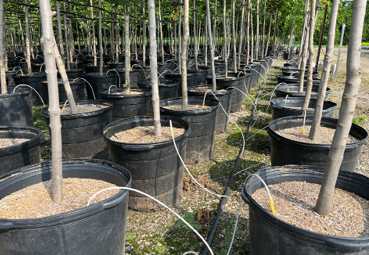
Our approach to mineral nutrition is ruled by the barrel analogy of Liebig's Law of the Minimum, which states that limiting mineral nutrients (or essential input) will limit plant growth and health. We as an industry may have gone too far, shoring up each barrel stave (i.e., nutrient) in excess, never revisiting the mineral nutrient program as a whole or considering excessive application and to what degree.
To ensure timely production of a saleable container-grown crop while minimizing loss or shrink, we alter our fertility program to add water soluble mineral nutrient amendments when blending the substrate, utilize a fertilizer formulation that ensures no macronutrients (N, P, K) become limiting, use controlled- release fertilizer with additional micronutrients (Fe, Mn, B, Zn, etc.), apply a medium-high to high label rate when incorporating or topdressing controlled-release fertilizers, and/or fertigating with water-soluble fertilizer during production. Layers of numerous assurances may be unneeded and detrimental to your bottom line. Additionally, we may be incorrectly measuring success as immediate growth or “greenness” instead of waiting for healthy crops of uniform size that can reach the market in a shorter or equivalent time frame. Revisiting these practices can reduce labor and decrease the need for additional inputs into the container, such as plant growth regulators and agrichemicals.
To evaluate your fertility, conduct small trials on a few important representative crops with different nutritional needs. These should be low-risk trials that could result in reduced costs, minimize shrinkage, and ensure timely production. These trials assume you are properly managing substrate pH (approx. 5 to 6; depending on plant) and water alkalinity (approx. 100 ppm bicarbonate); both key to a successful fertility program. Below are a few considerations when optimizing your fertilizer program.
Water
Regardless of source (ground or surface), your water contains mineral nutrients that are essential to plant growth. Much of the water used in production contains calcium, magnesium, iron, manganese and carbonates. Reused water collected in reservoirs often contains leached nitrogen, phosphorus and potassium. Routine water tests over the course of a season can provide insight into how your water changes month-to-month and contributes to your fertility program. In many cases, you may be substantially fertigating your crop unknowingly.
The lesser found problem is that of pure water, such as from snow melt or collected rainwater, which has very low alkalinity and electrical conductivity (i.e., mineral nutrients). Irrigation from these water sources can “strip” (i.e., leach) the container substrate of nutrients without replenishment requiring you to further hone your fertility program.
Amendments
When growers first adopted “container” mix, they contained mineral soil and did not closely resemble the subsequent peat- and bark-based “soilless” substrates utilized today. These original soil containing mixes incorporated agronomic or water-soluble fertilizers to ensure an adequate supply of mineral nutrients. Today’s substrates supply low to moderate amounts of micronutrients, decreasing as they age; however, the same substrates have little capacity to retain incorporated or applied nutrients. The widespread adoption of controlled-release fertilizers has reduced the need for additional water-soluble fertilizers to be incorporated or applied when growing semi-woody or woody shrubs over a duration of months. “Feeding the substrate,” nitrogen drawdown, or an initial loss of nitrogen to the substrate is rarely an issue since commercial substrate components and mixes have been stabilized prior to use in production and your fertilizer contains adequate amounts of nitrogen. Many growers use no amendments with little or no issue since substrate components can provide a near optimal pH (approx. 5). However, many people still add dolomite (lime) or sulfur balanced micronutrients. Alone, dolomite raises your pH decreasing iron and to a lesser degree manganese availability, whereas adding a micronutrient fertilizer package lowers your pH below optimal decreasing macronutrient availability. To overcome this adverse effect, simply add the label rate of micronutrients and then adjust pH using dolomite. These amendments will provide calcium, magnesium, sulfur and all necessary micronutrients, leaving controlled-release fertilizer as the final addition. Following a tight fertility program, fertigation or foliar application of mineral nutrients should only be required for an emergency.
Placement
Now, you must decide the best placement of your controlled-release fertilizer: incorporated, top-dressed, sub-dressed or dibbled. The selected placement can impact release rate but should primarily match your production scheme with the goal of only one application. Best management practices suggest incorporation of fertilizers to prevent container blow-over and spillage, keeping prills in the pots. Research from weed scientists Chris Marble at the University of Florida and James Altland, USDA-ARS, also informs us that subdress or dibble can aid in weed prevention by depriving weed seeds of nutrients that enable germination on the substrate surface; however, these benefits will be eliminated if you are knowingly or unknowingly fertigating. Another consideration is the number of colored containers you use. Recently, research from Jake Shreckhise of USDA-ARS, Jeb Fields of Louisiana State University AgCenter, Lloyd Nackley of Oregon State University and Owen has demonstrated that container color affects substrate temperature and subsequent release of nutrients from controlled-release fertilizer. The effect appears to be greater at lower latitudes where higher summer day/night temperatures occur; with Tom Fernandez reporting that black containers in Michigan warm up quickly giving the plant a needed push early in the season.
Next month, we’ll continue on the topic of fertilizer testing, covering formulation, longevity and rate.


Explore the January 2024 Issue
Check out more from this issue and find your next story to read.
Latest from Nursery Management
- John Ruter shares UGA's latest woody and herbaceous ornamental plant breeding projects
- Conor Foy joins EHR's national sales team
- Pantone announces its 2026 Color of the Year
- Syngenta granted federal registration for Trefinti nematicide/fungicide in ornamental market
- Get to know Kayela Aeppli
- HILA 2025 video highlights: John Gaydos of Proven Winners
- Q&A with Justin Bartlett
- Be the best choice





